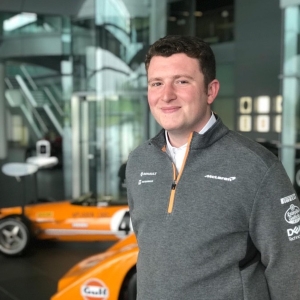Danielle Applestone: Come with me. We’re at Silverstone Circuit, Northwest of London, where we’ll take a lap with a professional Formula 1 driver. Ready? Well, that doesn’t matter because here we go. Okay. Seventh gear, 190 miles an hour as we approached the start, tires are still cold, up to eighth gear into turn one, fast through turns one and two. Now to the left, breaking hard for turn three. We’ve got to carry a bunch of speed through this one and quickly over to the right for that next left-hand turn. Okay. Power up. Got to build lots of speed out of the exit, along the straightaway. Here, the track gets bumpy, but the brisk headwinds create a strong downforce so we can break deeply into the Brooklyn’s Turn. Okay. That felt weird and we aren’t the only ones who think so. Nearby, in this control room, a group of engineers stare at real-time data readouts on the car. That turn didn’t feel right to them either. Sensor checks spit out pixelated reams of data about suspension, the engine, wind resistance, tires. On race day, these engineers would usually spring into action, analyzing data, running simulations, and speeding instructions to the pit and driver. But today, that can wait till after lunch because the race isn’t for another few days and our professional driver is a professional simulator driver, an e-sports champion recruited for the tech team. And a win today isn’t finishing first on the track. It’s collecting data, the digital fuel that powers Formula 1. By assessing data from that simulated lab, engineers can make decisions, retool parts, and contribute to strategies for race day, data that is only as good and as fast as the machines and devices that handle it.
I’m Danielle Applestone, engineer and entrepreneur. With fond memories of watching F1 races with my dad and rebuilding my dream car at the age of 18, a ’66 El Camino, if you must know. Buckle up, you’re listening to Technology Powers X, an original podcast from Dell Technologies. In this episode, technology powers that. If you can see inside a McLaren F1 car, of course, first you’ll have to get it to stand still. There. Looking under its skin, you’ll find engineer Valhalla. Little wonder, the women and men who attend them are rock stars in the engineering world.
Gemma Hatton: There’s about 14,500 components in a Formula 1 car, but it takes only eight hours to pull it apart and rebuild it back up again. That’s incredible.
Danielle Applestone: Gemma Hatton is a technical writer for motor sport and automotive. In her previous life as part of an F1 team, she’s had the rare privilege of getting under the proverbial hood of some of the world’s fastest cars.
Gemma Hatton: And that huge number of components are scorched in to such a tight space because Formula 1 cars need to be as slim as possible. They need to be as lightweight as possible. If they’ve got anything sticking out, they’re going to affect aerodynamics, which is going to lose lap time. So everything is so compact and refined. Yet, you’ve got an engine and motors and batteries operating at really high temperatures and you have to try and cool those. So there’s some cases where the packaging, when they’ve got a boiling hot exhaust pipe that they’re trying to cool next to a radiator or next to the engine.
Gemma Hatton: And it makes no sense logically, but it’s just because the importance in Formula 1 is that that packaging is so, so important because of the consequential benefits of the aerodynamics and that kind of stuff.
Danielle Applestone: Skillfully woven within that symphony of manifolds, metals and polymers is more than 300 sensors feeding masses of real-time information to the team’s engineers through an onboard electronic control unit or ECU, in addition to a dozen or so onboard cameras giving engineers eyes on scrutiny throughout a race. Okay. Away you go. Here in McLaren’s control room just off the track, a team of engineers watch readouts and analysis. When there’s a malfunction, the team goes to work turning raw data into actionable instructions to the pit crew and the driver sometimes in seconds. Gemma Hatton recalls working as a tire engineer with an F1 crew where the most vital of metrics is temperature.
Gemma Hatton: Not just on the surface of the robot, but in the middle of the rubber. Not just at one point on the surface of the rubber, but the whole spectrum of temperatures that you need in a tire. Something is because rubber is such a complex material that data that’s just an astronomical amount and it happens live and it’s right in your eyes. So before a driver is even finished skidding on a flat spot, I can see the spike in the front left tire temperature and can go, right, okay, I expect that tire to have a reduced wear life now because the driver’s just spun it. I didn’t even look at the camera. I could see it in the data. And that was just me, one component of a formula 1 team as a tire engineer.
Danielle Applestone: In a mere couple of decades, technology has produced a new generation of engineers practicing the sort of 21st century alchemy, transforming information into speed. Among the legendary names fixed to that process is McLaren, which has in just over a half century amassed 182 Grand Prix wins, 12 driver’s championships and eight constructor’s championships. Ed Green is principal digital architect at McLaren Racing.
Ed Green: Data and information is collected both from the car at the track, but then also sent back to the factory. And we do that by having traveling members of the team that go out to each circuit normally in 21 different locations around the globe, and we take a full IT infrastructure with us. We take over 110 terabytes of storage with us. We take a full rack of hyperconverged Dell infrastructure to every track, then at the edge we collect the data coming off the car, coming from the ECU on board, which analyzes all the different sensors. And at the edge, we collect all that data.
Danielle Applestone: Green reckons that on any given weekend, McLaren cars generate about one and a half terabytes of data from free practices on Friday, through qualifying on Saturday and a race on Sunday. And with the technology they bring, you won’t find Formula 1 engineers making any urgent trips to the parts store.
Ed Green: So we take a 3D printer, believe it or not, with us to each race track. And sometimes the speed of development means we’re producing over 17,000 new components each year. So the engineers are constantly innovating, constantly designing. And the general rule of thumb is the car that finishes first at the start of the season will almost certainly finished last by the end of the season. So you’ve got to keep pushing and keep designing, keep changing and keep innovating. So sometimes we’ll make parts of the track. We’ll take the 3D printer with us and we’ll produce parts on Saturday night and more often than not end up running those in the race on Sunday. So right from the production processes through to the build process, we then end up at the track where engineers and strategists will that data that comes from the car to help make decisions on track, where we should pit, what tires we should use, what strategy we run. So technology supports us throughout the whole design build and race cycle.
Danielle Applestone: Processing data at the edge has become almost as much a part of formula one as tires and fuel. So for that matter, has the intensive analysis run out of the core data center environment. For McLaren, that takes us here back to where we started at the team’s headquarters in Woking, in Surrey, England, which Ed Green describes as a Bond-like villain lair of a head office.
Ed Green: On a race weekend, we ship all of the data from the car back to the HQ. And in fact, most of the decision making is made from Woking from our mission control where up to 32 engineers sit and help make this pit stop calls. They make decisions upon tires. So a lot of that information is sent back in near real time. I think last weekend, when we were racing, we were at 57 milliseconds, so it’s pretty quick. And we do that to help support decision making at track. If we could, we take more engineers around the world with us, but it’s not always possible to do that. So all of the data is shipped back to HQ.
Danielle Applestone: The data constantly fed back to McLaren’s crews required different levels and different depths of response, which is why it’s critical for McLaren to have a data management strategy to harness all the data sources and an approach that leverages a variety of computing environments.
Sam Grocott: McLaren, like many organizations, needs to leverage a mix of edge and cloud and core data center environments to process all of this information that they’re capturing.
Danielle Applestone: Sam Grocott is senior vice president of marketing for Dell Technologies.
Sam Grocott: And McLaren’s edge environments sit actually trackside and they have this huge influx of information that come in from car sensors, things like weather reports and even biometrics on the individual car race drivers, and this information needs to be analyzed in absolutely real time. So in a sport that’s measured by milliseconds that determines kind of winners and losers of the day, they need to make sure that that data is very, very close to the information on the track. Now on the flip side, there are some activities such as machine learning or advanced analytics that require a much, much wider spectrum of compute horsepower. And these capabilities are more effectively run out of their core data center and using their core data center processing power capabilities, McLaren can analyze the car’s performance. They can look at past races, practice times and other simulations that they’ve run, and it really allows them to optimize the ultimate race strategy for any given race.
Danielle Applestone: Any doubt that tech is vital to Formula 1 racing vanished in 2012 on a Sunday in late November in Sao Paulo. Sebastian Vettel needed to finish in the top bore to secure his third street World Drivers Championship, but just 29 seconds into the first lap, disaster. His car was clipped, sustaining damage and forcing him into a spin. Within one second of the collision in a cramped control room under the grandstand, a crew of engineers were pouring over telemetry data fed from the sensors in Vettel’s car. By lap 10, the engineers had crunched the data, identified problems, run simulations and fed detailed instructions and a racing strategy to the pit crew.
Danielle Applestone: Vettel went on to finish third, securing his third straight title. For the team at the McLaren head office, those in-between hours on race weekends are a time to put data to work. Ed Green.
Ed Green: As soon as we get all the data from free practice, we’ll be using that to simulate the race and we’ll simulate over 300 million permutations of the race. And that helps us understand by the first corner who’s in front of us, who could have spun, who could have not got off the line as quickly. And throughout the first lap of the race, we start to decay off those 300 million simulations of the race and get down to the likelihood. And within the first couple of laps, we can start to predict what will happen across the race, and then start to plan our strategy and our pit stops accordingly.
Ed Green: So all of the data is sent back to Woking and then simulations are run both here at the McLaren Technology Center and at the track.
Danielle Applestone: After years of intense competition among armies of gifted engineers, a by-product has emerged. Formula 1 has given the automotive world a succession of remarkable innovations. Witness the kinetic energy braking system or KERS developed for F1 use. It captures energy used for braking and reuses it for acceleration, making use of energy otherwise wasted. In 2019, Volvo announced it would be adding KERS to its production cars, suggesting it will improve fuel economy by 15%. It’s this sort of innovation that’s making F1 an unexpected champion of sustainability. Gemma Hatton.
Gemma Hatton: Formula 1 is really, really driving home the sustainability message. Those technologies are fantastic. And it’s the same with the MGU-H, which is a very similar system, but works on the exhaust. So it recovers the heat energy from the exhaust gases in a similar way, it drives a turbine, stores energy, that energy can later be deployed for additional boost as well. So those are probably the most fantastic technologies that have come out of Formula 1.
Danielle Applestone: While F1’s electric counterpart Formula E is advancing technology in electric cars, Formula 1 is moving towards use of biofuels. Meanwhile, McLaren has developed a racing seat using fabric architecture to optimize the properties of flax fibers. The resulting material provides the required strength and stiffness, but with a 75% lower CO2 footprint compared to carbon fiber. To Gemma Hatton, it’s no mystery that professional racing is a great proving ground for automotive innovation, given its relentless push for even the smallest advantage.
Gemma Hatton: It’s got to be lighter. It’s got to be stronger. It’s got to be stiffer. It has to be smaller. It’s got to fit in the space that it can’t fit in. And that’s why there’s such high optimization and there’s so many … There’s hundreds of engineers and really clever brains constantly trying to solve this problem. And the problem never goes away because you can always have a lighter race car. You can always have a more efficiently packaged power unit and cooling systems. And you then take that package to the race car and you have the race team and the driver then pushing that package as a whole to its absolute limits as well.
Gemma Hatton: So you can imagine when you’re trying to test out a piece of technology, no matter how small it is, how motor sport can be such a valuable testing platform for that technology because everything is pushed to its limits.
Danielle Applestone: Back at McLaren’s applied division, lessons from its Formula 1 technology are paying real world dividends outside the racing world. Ed Green.
Ed Green: So taking the technology from Formula 1 and applying it across different verticals, such as healthcare and business processes, strong heritage in motor sport electronics, a lot of the ECUs that we see, which are the onboard computers that exist both across every Formula 1 car, every NASCAR, every IndyCar, but also the applied businesses is superb at modeling and simulating for lots of different business lines, understanding how to produce products, what the most efficient route of production might be.
Danielle Applestone: One product of this thinking is a partnership announced in January 2020. McLaren Applied and a company called Orthosensor, Inc. were developing wearable sensors and data analytics relating to patient care and orthopedic procedures. McLaren’s contribution would be quantifiable technology and machine learning capabilities developed by its Formula 1 team. With every season, every race, the cycle continues. Technology drives F1 racing, which in turn drives technology, a perfect symbiosis or two disciplines in which standing still is not an option.
Danielle Applestone: This is Technology Powers X, an original podcast from Dell Technologies. For more information on the McLaren Racing Team, visit DellTechnologies.com/McLaren. To read the show notes for this episode, visit DellTechnologies.com/TechnologyPowersX. I’m Danielle Applestone. Thanks for listening.
 Dell Solutions with Intel®
Dell Solutions with Intel® Gemma Hatton
Director & Technical Writer, Fluencial
Gemma Hatton
Director & Technical Writer, Fluencial
 Ed Green
Principal Digital Architect, McLaren Racing
Ed Green
Principal Digital Architect, McLaren Racing
 Sam Grocott
SVP, Business Unit Marketing, Dell Technologies
Sam Grocott
SVP, Business Unit Marketing, Dell Technologies
